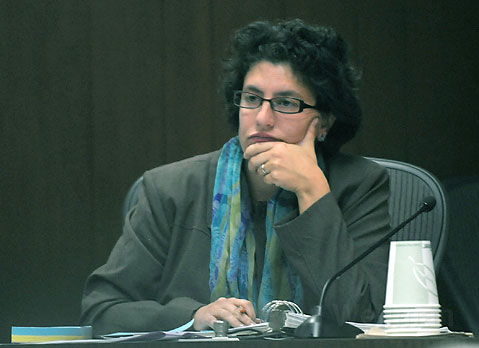Schneider on Hot Seat
Height Initiative Wins Tactical Victory

An obviously agonized Helene Schneider-Santa Barbara City councilmember and mayoral candidate-cast the key vote giving traditional slow-growthers active with Save El Pueblo Viejo a significant tactical victory in their battle to put an initiative limiting the maximum size of new buildings on the November election ballot.
The initiative would reduce the maximum downtown building height from 60 feet to 40 and cap building heights throughout the rest of the city to no more than 45 feet. Initiative supporters-fearful that the city’s historic skyline could be gobbled up by 60-foot structures like the ones springing up on Chapala Street-packed the council chambers to demand a straight up-or-down vote on a ballot uncluttered with confusing alternatives. Critics of the initiative-which includes a rough coalition of affordable housing advocates, developers, architects, “smart growth” supporters, and sustainability wonks-have lobbied almost as intensely for competing ballot language that would embrace the same height restrictions as the Save El Pueblo initiative but allow limited exemptions for projects with at least 30 percent of the housing affordable to middle-income buyers.
Dressed in electric lime-green T-shirts, Save El Pueblo supporters denounced the alternative-drafted by councilmembers Das Williams and Grant House-as an effort to leave voters, in the words of signature gatherer Bill Marks, “hornswoggled, boondoggled, or conned.” Marks, who helped collect the 11,000 signatures to qualify the initiative for November’s ballot, noted that nothing in the alternative would have prevented the sprawling Chapala One development located at Chapala and Gutierrez streets from being approved. More than 30 percent of the Chapala One units, Marks noted, are affordable.
Schneider cast the tie-breaking vote to keep the alternative off the ballot, despite having initially criticized the initiative as “too simplistic” and having voted twice to authorize City Hall to pursue alternative language. After listening to the community and members of the city’s many boards and commissions, Schneider said she concluded that the alternative language was just not right. By voting against the alternative, however, Schneider found herself breaking with many close political friends and allies in the affordable housing and sustainability camp. Privately, she said the alternative process was fatally uncertain; the public would not vote on the precise enabling ordinance language until some indeterminate time after having voted in favor of the alternative itself. And that’s assuming that there would be five city councilmembers-the minimum legally required-willing to place it on the ballot.
None of this washed, however, with Mickey Flacks, an iconic affordable housing activist who until Tuesday was also a Schneider supporter. Flacks dismissed the vote as “politically calculated” and said she would no longer support Schneider in her mayoral run. (Flacks also said she would not support Councilmember Iya Falcone, whom Schnieder is now running against.) Despite past criticisms of the initiative, Schneider declined for the time being to state whether she would support it or oppose it come November.
While Schneider’s vote came after much deliberation, Falcone experienced no such difficulties. She’s opposed the initiative almost from its inception, she said, and she opposed any efforts to place an alternative before the voters. To the extent there’s a problem that needs fixing, Falcone said City Hall could and should craft new ordinances to limit the size, bulk, and scale of prospective Chapala Ones.
Joining Falcone and Schneider to exclude the alternative was Mayor Marty Blum and Councilmember Dale Francisco. Joining Williams and House in supporting the alternative was Councilmember Roger Horton. Horton pointed out that the City Council never approved any of the projects on Chapala Street and that no civic groups now supporting the initiative appealed those projects to the council. He took offense that these developments had been approved by the city’s Planning Commission, and some of the most ardent supporters of the initiative were the very planning commissioners who approved them.



